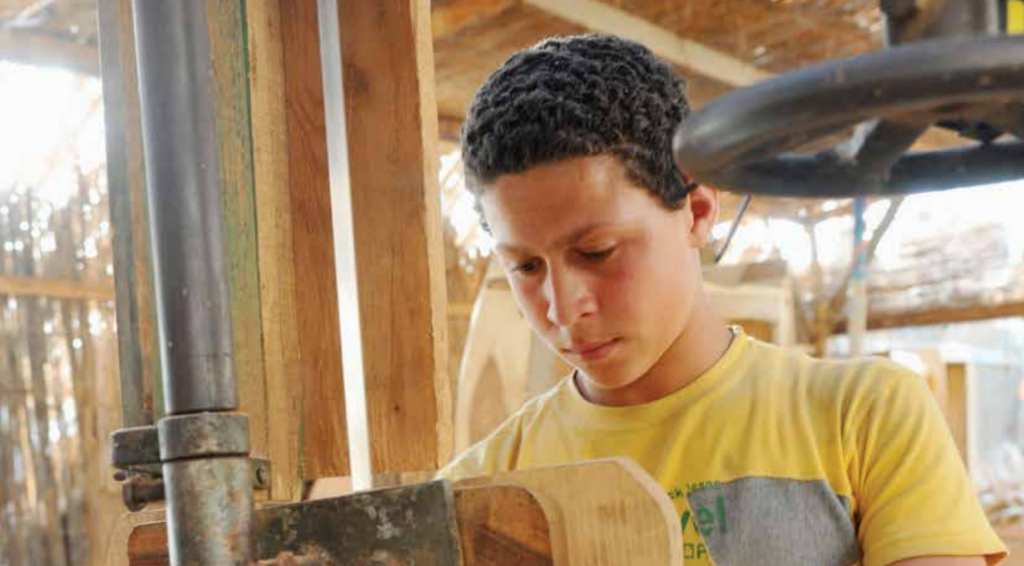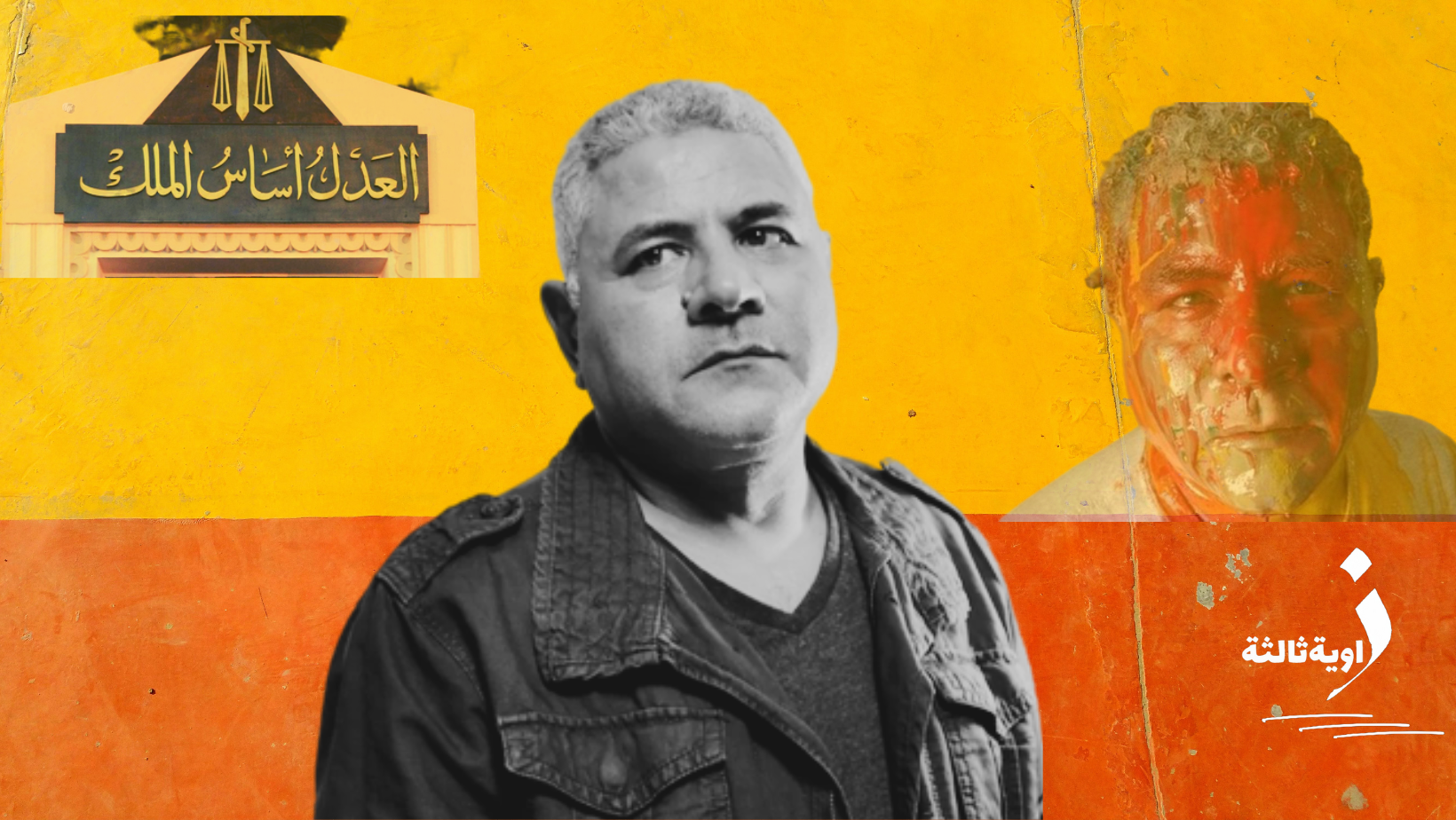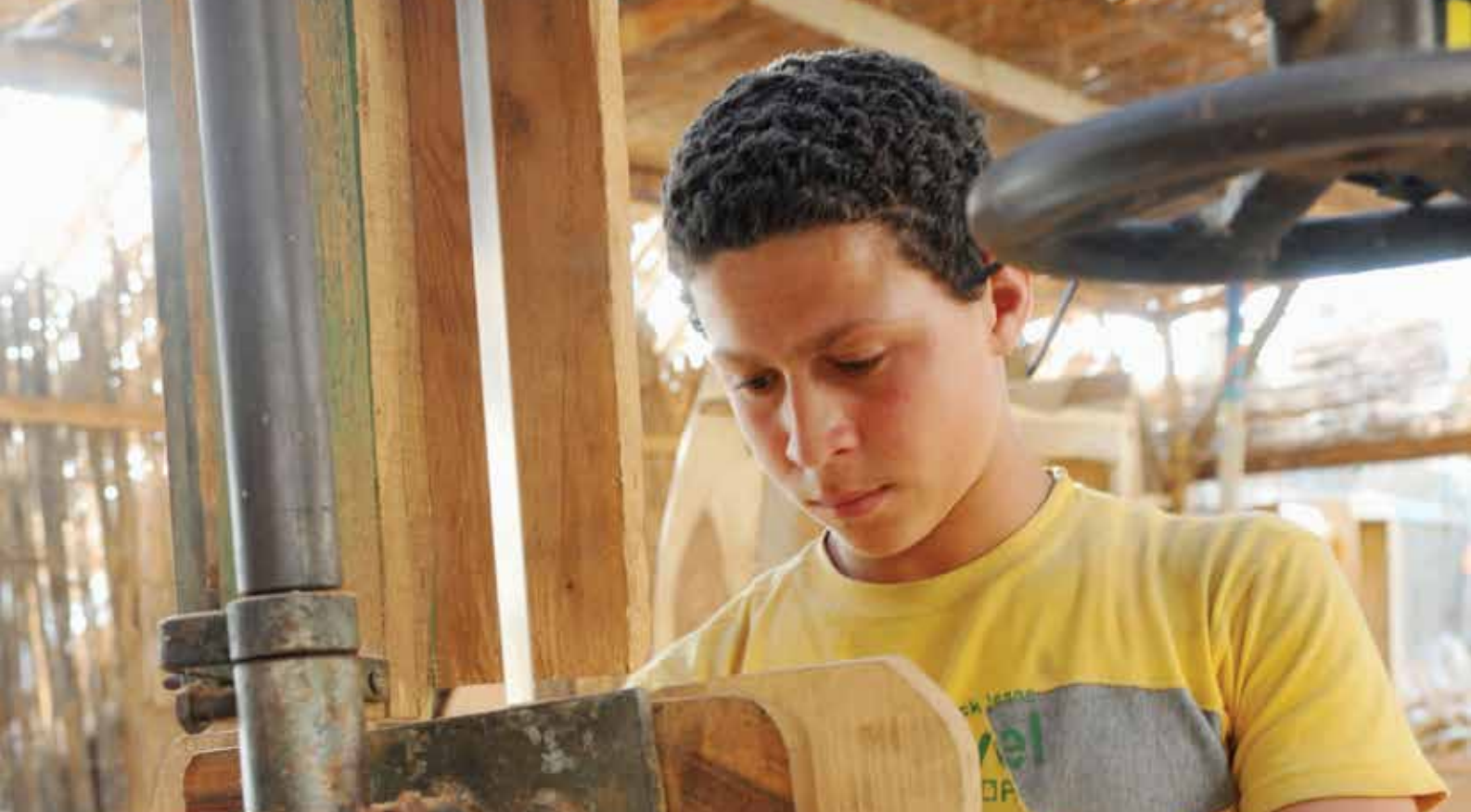In January of last year, specifically in the village of Al-Ghanamia, located in Ashmoun district, in the governorate of Menoufia, Egypt, a car carrying 23 children stumbled. It wasn’t on their way back from school; they were returning from their workplace after completing a workday that exceeded 12 hours.
Ten girls and thirteen boys, all of whom were working on a poultry farm to collect eggs, found themselves in a car that fell into the Nile River while crossing from one side to the other on a makeshift ferry. The driver lost control of the brakes, causing the car to plunge into the water. The incident resulted in the retrieval of 8 children’s bodies, the last of whom was the 16-year-old girl, Shorouk Yasser. The river rescue forces managed to recover her body after 7 days of searching, as her family identified her by her hair, as her features had disappeared after being submerged for an extended period, causing parts of her skin to decompose underwater.
Drowning during river crossings is a common occurrence in Egypt, as stated by MP Mohammed Abdullah Zain El-Din, a member of the Transport Committee in the House of Representatives. He noted that the ferries spread across multiple governorates nationwide suffer from deterioration and inadequacy in transporting individuals and belongings, leading to drowning accidents that result in deaths and injuries. Egypt has nearly 10,000 ferries spread across the country, serving about 144 islands along the Nile River, in addition to villages separated from other areas by branches of the Nile. He added that all these ferries are in urgent need of maintenance or replacement with bridges to facilitate citizens’ movement.
The ages of the victims ranged from 13 to 17 years old, and all of them belonged to the village of Talia in Ashmoun district, Menoufia governorate, Egypt. Each of the eight children who lost their lives was receiving a daily wage ranging from 30 to 50 Egyptian pounds (approximately between 97 cents and 1.5 US dollars) for their work on that farm.
In response to this incident, President Abdel Fattah el-Sisi issued directives to the Prime Minister to construct a dedicated bridge for the residents of the area, aiming to facilitate their movement and prevent the recurrence of such accidents. He also ordered the “Tahya Misr” Fund to provide immediate assistance of 20,000 Egyptian pounds (approximately 650 dollars) to the families of the deceased. Additionally, the Ministry of Local Development allocated 500,000 Egyptian pounds (approximately 16,000 dollars) to support the families of the deceased children after conducting a social investigation.
One-way journey
The drowning of children was not an exceptional incident, as multiple incidents of child fatalities in Egypt during their journeys to work have been reported. Taking a quick look at accidents resulting in the death of children while working in 2021, we find the following examples:
– In December 2021, two children were killed, and 24 others, including children, were injured in the overturning of a pickup truck in the area of “Wuslat Al-Dawawees” on the Cairo-Qasaseen road, within the jurisdiction of the new Qasaseen district in Ismailia. They were on their way to the “Jana Al-Basal” farm. This incident left 18 injured children in addition to the two deceased, with the ages of the children ranging from 10 to 15 years old.
– In August 2021, in the area of Atfeeh, the body of a child was found hanged by a rope at the hands of unknown assailants after his disappearance for a whole day. They threw his body in the cemetery. The child was working on a tuk-tuk to help his father, who had become disabled following an accident, but three individuals killed the child to steal the tuk-tuk.
– In May 2021, a quarter-ton truck accident on the Western Sahara Desert Road in Upper Egypt claimed the lives of two children and injured 21 others while they were returning from work in a farm along the Western Sahara Desert Highway.
Child Labor
Child labor is considered one of the most pressing issues in Egyptian society in general and specifically in Damietta’s community due to its industrial nature, relying on the workforce of young hands. A research study conducted by the Swiss organization “Terre des Hommes” Foundation, which focuses on child protection work, revealed an increase in the number of working children in Damietta governorate. The governorate ranks fourth among five governorates, including Fayoum, Minya, Sharqia, Damietta, and Gharbia. According to the National Survey on Child Labor in Egypt, issued by the National Council for Childhood and Motherhood, there are 2.76 million working children in Egypt, accounting for about 26%, which is more than one-fifth of children aged 14 to 16 years old.
According to the National Survey on Child Labor in Egypt conducted by the Central Agency for Public Mobilization and Statistics (CAPMAS) and the International Program on the Elimination of Child Labor (IPEC) in 2010, approximately 1.6 million children between the ages of 12 and 17 are working in Egypt. This is equivalent to 9.3% of the total number of children in the country, meaning that one child is working out of every ten children. About 82.2% of these children are exposed to poor and unsafe working conditions. In July 2018, the Ministry of Manpower, in collaboration with the International Labour Organization (ILO) office in Cairo, launched the National Plan for Combating the Worst Forms of Child Labor in Egypt and Supporting Families (2018-2025). During the celebration of the plan’s launch, the former Minister of Manpower, Mohamed Saafan, stated that child labor is a crime that must be stopped, affirming the government’s efforts to uplift Egyptian families and provide them with adequate income to prevent the need for child labor. The plan identifies the worst forms of child exploitation, such as forms resembling slavery, including child trafficking, forced labor, and the use, recruitment, or offering of children for prostitution, pornography, or illicit activities that harm the children’s health and well-being.
Types of Work Performed by Children in Egypt
Child labor in Egypt involves various hazardous and exhausting occupations, with notable examples being agricultural work such as cotton, corn, and vegetable fields, as well as tending to livestock. Child labor is also prevalent in fishing and marine-related work, stone quarries, mines, carpentry, blacksmithing, handicrafts, traditional industries, recycling garbage and waste, street vending in markets, trains, and metro, domestic work including laundry, house cleaning, and childcare, as well as labor in construction and building sites carrying construction materials. The highest rates of child labor are concentrated in rural areas, especially in Upper Egypt governorates.
Causes of Child Labor Spread in Egypt
The phenomenon of child labor in several regions can be attributed to certain social factors. These include customs and traditions that promote the idea that child labor is a source of pride and a sign of maturity and excellence, forcing children to enter the labor market at an early age. The roots of child labor can be traced back to extreme poverty and the low standard of living for a significant portion of the population, alongside widespread illiteracy and children dropping out of school at an early age. Unregistered business owners often rely on minors to carry out most of the work in their establishments because they can pay them significantly lower wages compared to adults. For instance, thousands of poultry farms in Egypt depend on minors for cleaning the farms, feeding the chickens, and collecting and packaging eggs. Child labor is also prevalent in stone quarries in Minya and in the agricultural lands of the Nile Valley and Delta. Thousands of unlicensed factories and workshops in the country rely heavily on child labor, forming the backbone of the workforce.
Poverty
Hasan El-Khouly, a sociology professor at Ain Shams University, stated: “Widespread poverty is the main reason behind child labor in our country. Poor families usually force their children to leave school and work to earn a living.” Poverty is the primary cause pushing families to send their children into the labor market. Estimates indicate that the poverty rate reached 32.5% in Egypt in 2018, according to the International Monetary Fund’s report “Regional Economic Outlook: Middle East and Central Asia,” October 2018. Due to the inability of many families to meet their children’s basic needs for food, clothing, and education, they resort to sending them to work and contribute to the family’s income. The Sisi administration is making significant efforts to lift hundreds of thousands of people out of poverty, including expanding social protection for the poor through a series of programs. One of these programs, called “Takaful and Karama,” provides financial support to the poor, especially given the rising food prices. Approximately 3.1 million families, or 11.1 million individuals, are enrolled in this program, and the government is working to increase this number. Despite President Sisi’s efforts to improve the standard of living and provide social protection for the poor, these efforts have not been sufficient to effectively address the issue of child labor. The country needs multi-faceted strategies to tackle this issue, including education, creating job opportunities for adults, and improving the living conditions of poor families.
Illiteracy Rate
The illiteracy rate in Egypt was approximately 25% in 2017, according to UNESCO’s Global Education Monitoring Report 2017, Egypt Profile. This reflects the low awareness among families about the importance of education. Moreover, children dropping out of schools increases the likelihood of their entry into the labor market. Working children are usually individuals who have abandoned their education and prefer to earn a living instead of attending classes, jeopardizing the production of the next generation of Egyptians who are illiterate. In 2019, there were 18.4 million illiterate people in the country, constituting 24.6% of the total population of 100 million people. Poor and large families in rural Egypt tend to compel their children to give up education and work to support their livelihood and feed the family.
State Efforts and Weak Law Enforcement
Article 64 of the Egyptian Child Law prohibits the employment of children under the age of 15. However, the same article allows governors to approve the employment of children under 15 in seasonal occupations that do not harm their health. Despite having laws that prohibit child labor, there are shortcomings in effectively enforcing these laws. Additionally, there is a lack of monitoring and accountability mechanisms. Article 80 of the Egyptian Constitution obligates the state to care for and protect children from all forms of violence, abuse, exploitation, sexual and commercial exploitation. It also prohibits their employment before completing basic education and engaging in hazardous work. Egypt has committed itself to combat child labor by ratifying relevant agreements, including the UN Convention on the Rights of the Child, the ILO Convention No. 138 concerning the Minimum Age for Employment, the ILO Convention No. 182 on the Worst Forms of Child Labor, and ILO Convention No. 129 on Labor Inspection in Agriculture. Under the supervision of the Ministry of Labor and in collaboration with the World Food Program, UNICEF, and the ILO, a project aimed at withdrawing 4,300 children from the labor market in three governorates was implemented. This was achieved through providing educational programs and incentives to children at risk of entering the labor market. From 2004 to 2006, 632 children were re-enrolled in primary education, 3,830 in literacy classes, 5,108 in community schools, and 2,005 in vocational training centers. Moreover, 371 children were removed from the worst forms of child labor. Social services were provided to 2,938 children, health services to 600 children, and financial aid to 236 children. A total of 1,653 awareness-raising study circles were organized.
According to a joint study by the International Labor Organization and the Ministry of Labor in Egypt, as part of efforts to combat the worst forms of child labor and promote sustainable livelihoods in the agricultural sector, the Ministry of Labor, in cooperation with the World Food Program, UNICEF, and the ILO, implemented training programs for labor and occupational health inspectors, child labor inspectors, and vocational advancement management. The focus was on inspecting special categories of children, women, and people with disabilities. The capacities of labor inspectors to enforce international and national labor standards and laws were strengthened. These efforts, in collaboration between the organization and the Ministry of Labor, aimed to improve the quality of labor inspection, occupational safety, and health, as well as enhance vocational advancement. Under the supervision of the Ministry of Labor, the program “Enhancing Workers’ Rights and Competitiveness in Egyptian Export Industries” was implemented in cooperation with the International Labor Organization. From November 2013 to March 2018, 911 inspectors were trained on international labor standards. The capacities of labor inspectors are being further enhanced through training workshops based on a participatory approach to improve the effectiveness of inspection visits and make workplaces safer.
Negative Effects and Proposed Solutions
According to our review of several studies, child labor has numerous negative effects on both the child and the society, including adverse impacts on the physical, mental, and psychological growth of the child, exposure to injuries and occupational diseases due to working in unsafe environments, deprivation of educational opportunities and necessary skills, as well as feelings of frustration, loss of self-confidence, and a sense of inferiority. Additionally, one of the negative consequences is the vulnerability of children to deviation, delinquency, and falling into the clutches of extremism and terrorism, perpetuating the cycle of poverty across generations. Economic productivity is also affected due to the lack of skills and education among child laborers.
Several proposed solutions have been suggested in various studies, and we have gathered the following:
– Enforcing stricter age limits and laws against employers exploiting children.
– Conducting intensive inspection and supervision campaigns at workplaces to address violations.
– Implementing wide-ranging community awareness programs about the risks of child labor.
– Improving the education environment and reducing school dropout rates by providing support to poor families.
– Providing social assistance and financial aid to poor families to prevent child labor.
– Supporting small lending projects and empowering women to increase household income.
– Activating the role of community oversight through civil society organizations.
– Adopting initiatives that encourage companies and businessmen to contribute to combating child labor.
Child labor remains one of the most significant social and economic challenges facing the Egyptian state, requiring a serious confrontation through a comprehensive strategy encompassing legislative, economic, educational, and social reforms to ensure the protection of childhood and provide a healthy environment for the growth of future generations. Addressing this issue necessitates the collaboration of the government, civil society institutions, and the private sector to combat this scourge and secure Egypt’s future.
Sources
[1] UNICEF statement on child labor in Egypt 2019
[2] International Monetary Fund, Regional Economic Outlook: Middle East and Central Asia, October 2018
[3] UNESCO, Global Education Monitoring Report 2017, Egypt file
[4] Central Agency for Public Mobilization and Statistics, Education Indicators Report 2018
[5] International Labour Organization, Report “Combating Child Labor in Egypt,” March 2016
[6] Article “Death of children in Menoufia highlights the problem of child labor,” Al-Masry Al-Youm newspaper, January 2022
[7] Article “Child labor in Egypt: Causes and solutions,” International Policy Magazine, 2020
[8] Report “Child Labor Situation in Egypt,” National Council for Childhood and Motherhood, 2018
[9] Article “Child labor assumes fatal proportions in Egypt,” Al-Monitor, January 2022







